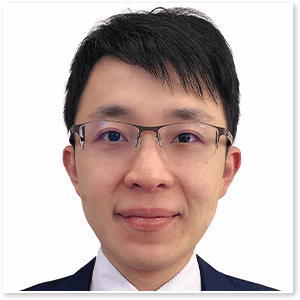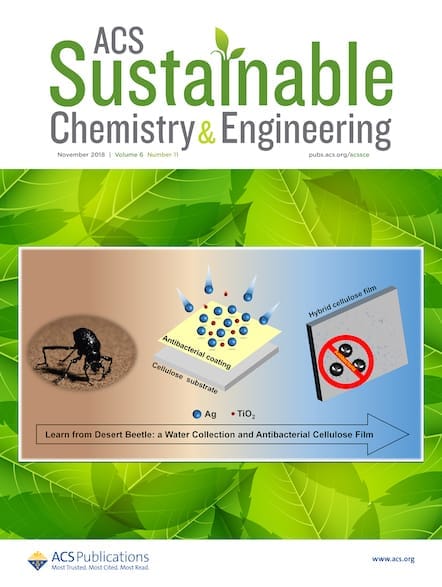Learn more about the 2022 winners and their noteworthy research.

The Editors of ACS Sustainable Chemistry & Engineering and the ACS Green Chemistry Institute are proud to celebrate the winners of the 2022 ACS Sustainable Chemistry Lectureship Awards:
- Timothy Noël, Van’t Hoff Institute for Molecular Sciences, University of Amsterdam, The Netherlands
- Shu-Yuan Pan, National Taiwan University
- Corinne Scown, Lawrence Berkeley National Laboratory, University of California, Berkeley, USA
These annual awards recognize the research contributions of scientists, working in green chemistry, green engineering, and sustainability in the chemical enterprise, who have completed their academic training within the past 10 years. Lectureship award winners are selected for three regions: The Americas, Europe/Middle East/Africa, and Asia/Pacific.
Read on to learn more about each of the three winners.
Timothy Noël

Professor Timothy Noël of the Van’t Hoff Institute for Molecular Sciences at the University of Amsterdam, The Netherlands, was “honored for his contributions to continuous flow chemistry, building tools that bridge chemistry and chemical engineering,” wrote ACS Sustainable Chemistry & Engineering Editor-in-Chief David T. Allen in his Editorial announcing this year’s award winners.
We asked Professor Noël to tell us more about himself. Here’s what he said:
How is your research specifically important to your region of the world versus on a global scale?
I believe that our research can be of added value to both academia and industry around the world. It is clear that continuous manufacturing principles will be increasingly implemented in the production of pharmaceuticals and agrochemicals, as it enables more efficient processes. It is our goal to help and make this transition possible.
What would you like government and/or industry representatives to understand about your research?
The merger of synthetic organic chemistry and chemical engineering allows us to push the boundaries of what is possible in synthesis. In addition, the use of flow chemistry enables a more facile transition between academic discovery of new synthetic methods and its subsequent use in the industrial production of chemicals.
Tell us about a research collaboration your group has undertaken.
We are proud of the fact that much of research is done in direct collaboration with people from industry. Such collaborations allow us to solve some real-life problems and the solutions can directly impact society.
What type of work can we look forward to seeing from you in the future?
We continue working on synthetic methods which exploit photons and electrons to drive reactions forward. The aim is to explore new chemical ground using reagents that are challenging to use in conventional round-bottom flasks. As an example, think about gaseous reagents which are often avoided due to the issues associated to handle those in batch. In addition, we always try to develop new reactor technologies which can increase the reaction efficiency of those transformations and enables their scale up.
Shu-Yuan Pan

Professor Shu-Yuan Pan of the National Taiwan University, Taipei, Taiwan, was “honored for his contributions to the development of innovative circular technologies for waste valorization as biochemicals, green materials, and reclaimed water,” wrote Professor Allen.
We asked Professor Pan to tell us more about himself. Here’s what he said:
How is your research specifically important to your region of the world versus on a global scale?
Our Green Technology Lab (GTLab) research provides a complete solution to the global industries and agricultural sectors with huge amounts of wastewater and/or solid waste. Our developed technologies aim to tackle wide-ranging challenges from industrial and agricultural cleaner production to sustainable community development.
For instance, we design “cascade separation” by integrating various separation mechanisms, such as chemical extraction, (ion-exchange) adsorption, electrokinetic migration, electrochemical reaction, and crystallization. This technology can be deployed for treating organic wastewater originating from local piggery industries, thereby ensuring a safe and clean watershed while achieving a circular bioeconomy. Moreover, we develop a high-efficient mineralization process utilizing industrial CO2 for upgrading the alkaline wastes to green construction materials. We found that a substantial amount of CO2 could be directly fixed and indirectly avoided by the mineralization processes. This would greatly impact global CO2 challenges and current solid waste management practices, especially in the US, China, India, and Korea.
What would you like government and/or industry representatives to understand about your research?
Our research provides a ground-breaking impact on the pathway to accelerate the realization of a circular economy in various sectors. Our developed technologies can reduce the anthropogenic impacts on ecosystems while avoiding extensive resource exploitation.
One of our current research focuses on developing energy-efficient processes for extracting valuable resources, including humic substances, organic acids, nutrients, and chemicals, from various types of wastes in agriculture, industry, and the domestic community. We design the processes based on the characteristics of target compounds from the thermodynamics perspective and evaluate the performance of processes from lab-scale validation to a large-scale demonstration. For example, we synthesize compound-oriented conductive materials to maximize the separation efficiency and the purity of products (e.g., organic acids and nutrients), which has a huge competence to the existing market product. Our demonstration could provide sufficient information to policymakers for identifying the best available circular technologies.
Tell us about a research collaboration your group has undertaken.
Our group has a close, long-term collaboration with Argonne National Laboratory, Idaho National Laboratory, Ohio State University, University of Delaware, and the University of Seoul. The Ministry of Science and Technology, Taiwan, and the National Taiwan University have continuously supported our research through the Einstein Project and the Higher Education SPROUT Project, respectively. Our team has recently established collaborative R&D programs with the University of Tsukuba, and several local industries in Taiwan to explore and implement the circular bioeconomy principles.
What type of work can we look forward to seeing from you in the future?
We keep dedicating ourselves to developing and implementing green circular technologies for waste valorization from the perspective of green chemistry principles. We design the fit-for-purpose and energy-efficient processes to recover value-added resources, produce clean water, and even produce bioenergy from wastes with affordable costs.
In particular, we design various processes and advanced functional materials to precisely recover valuable compounds from a complex waste matrix. This could provide opportunities to establish a new industry, so-called circular industries, to achieve the goal of responsible consumption and production while contributing to the net-zero emission target.
Corinne Scown

Dr. Corinne Scown of the Lawrence Berkeley National Laboratory and the University of California, Berkeley, USA, was “honored for her contributions integrating emerging technology development with rigorous technoeconomic analysis and life-cycle assessment,” wrote Professor Allen.
We asked Dr. Scown to tell us more about herself. Here’s what she said:
How is your research specifically important to your region of the world versus on a global scale?
Much of my group’s work focuses on the United States, but I like to think that most of our findings transcend national boundaries. Analyses of the cost, greenhouse gas, and water impacts of an individual bioenergy facility can be easily translated to other countries with some basic adjustments to basic parameters like input costs and regional grid mixes. However, for research focused on global-scale implementation of a given decarbonization strategy, the limiting factor is data availability. I’m hopeful that the trend toward making research code open-source and sharing underlying datasets will make this less of an issue in the future.
What would you like government and/or industry representatives to understand about your research?
I’m fortunate enough to interact with folks in government (Federal and California State) and industry on a regular basis so it’s not uncommon that I get an opportunity to directly share my research with them. One takeaway from my work that is worth emphasizing is that it’s important to consider multiple economic and environmental impacts together before making a decision.
We did some work on organic waste management a few years ago, where we compared alternatives ranging from landfilling to composting to anaerobic digestion. From a climate standpoint, it was clear that landfilling was by far the most carbon-intensive option and composting was probably the cheapest way to avoid those emissions. However, we were completely surprised when we saw the estimates of ammonia emissions from composting nitrogen-rich food waste and the potential air quality and human health consequences.
In that particular case, there is still a lot of uncertainty surrounding how ammonia may react with other species in the atmosphere to form harmful fine particulate matter, but it was a stark reminder of how we can develop blind spots when we only focus on a single metric, like greenhouse gas emissions.
Tell us about a research collaboration your group has undertaken.
One of the most interdisciplinary and fun collaborations has been a recent project with synthetic biologists, led by Jay Keasling, and material scientists include Brett Helms and Kristin Persson. We have been working together on polydiketoenamines (PDKs), which are polymers that can be depolymerized under mild conditions to recovery virgin-quality monomers and separate out fillers, dyes, and other additives that would otherwise degrade the quality with each recycle.
My group’s task was to take the chemistry being done in the lab and actually design and simulate how these PDKs would be synthesized and recycled in a hypothetical industrial facility. We quickly identified a few key inputs that were driving the costs and greenhouse gas emissions associated with producing the virgin PDK.
Incredibly, within a few months, Brett and his team were able to take that feedback and develop an alternative process that totally eliminated the biggest contributor. The costs and greenhouse gas footprint both dropped by more than half. It is so gratifying to see that sort of impact and I’m excited to see where that project goes in the future.
What type of work can we look forward to seeing from you in the future?
I am particularly excited about the potential for the bioeconomy to play a role in removing carbon from the atmosphere. There is a lot we don’t yet know about the best ways to do that, from a systems perspective, because some of the strategies are so nascent.
Technoeconomic analysis and life-cycle assessment, when paired with science and early-stage technology development, have much to offer because we can design systems that would be impactful and cost-effective and work backwards to identify where the technological or scientific gaps remain. There will always be low-hanging fruit; capturing CO2-rich gaseous streams from biorefineries and sequestering them underground seems like one of the more obvious places to start and we’ve done some preliminary work on that. Sequestering carbon in long-lived products like building materials is also interesting. In the future, we may tackle more complex and novel strategies related to the agriculture sector (for example, altering plant root exudates to sequester more carbon into the soil), and figure out what it would look like at scale and how much it is likely to cost per tonne of CO2 mitigated.
There is still so much to be worked out in terms of the practical implications of doing something like that at scale, as well as the measurement and verification needed to ensure that it’s having the intended effect. My team is working on a big collaborative report that tackles the challenge of a net carbon-negative bioeconomy for the United States. That said, I would absolutely love to start building models that simulate how we might be able to do this at a global scale in an equitable and just manner.
